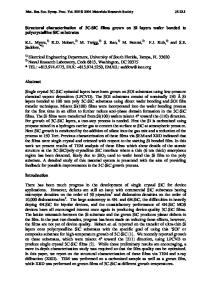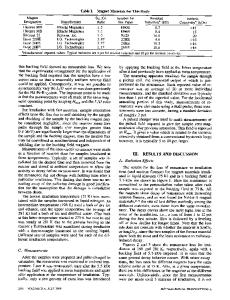Microstructure of Polycrystalline Sic Containing Excess Si after Neutron Irradiation
- PDF / 1,880,147 Bytes
- 6 Pages / 417.6 x 639 pts Page_size
- 86 Downloads / 390 Views
and Tan,
eds.
Defects in Semiconductors
527
MICROSTRUCTURE OF POLYCRYSTALLINE SIC IRRADIATION
CONTAINING EXCESS SI AFTER NEUTRON
S.D. HARRISON AND J.C. CORELLI Dept. Nuclear Engineering, Rensselaer Polytechnic Institute, Troy,NY 12181 USA
ABSTRACT The microstructure of commercially available reactionbonded polycrystalline SiC containing 8-10 wt% excess silicon was studied after irradiation by reactor neutrons uitlizing transmission electron microscopy (TEM) and scanning electron microscopy (SEI). For TEM studies on samples irradiated 0 below 473 K we observe dislocation tangles near grain boundaries or impurities plus isolated dislocations throughout the remainder of the grain, whereas for irradiation temperatures 0 of 41373 K the material exhibits copious quantities of "black spot" defects (2-5nm size) and a lower concentration of tangles than 473°K irradiation. The SEM studies of surfaces of samples fractured at 1473°K indicate that the mode of fracture is predominantly transgranular.
INTRODUCTION The ceramic material SiC has some unique properties which make it useful in high temperature nuclear fusion reactor applications (eg: first wall, limiter, etc.). The advantages as well as the disadvantages in the use of SiC for nuclear fusion applications have been described in quite some detail by Rovner and Hopkins [1] and will not be stated here. Since the structures used in fusion reactors will be subjected to intense neutron fields (14MeV neutrons), as well as ions,X-rays, and gamma radiation it is important to study the response of the material to simulated radiation fields. In recent years there have been a number of studies on the fracture, swelling,and thermal properties of various forms of SiC material [2,3,4,5,6]. However, detailed studies of the microstructure response of irradiated commercially available silicon carbide have not been reported. In this paper we shall report on the microstructural changes in reactor neutron irradiated SiC for which we also have made studies on the response of the mechanical properties (fracture strength, swelling) following neutron irradiation. EXPERIMENTAL METHODS AND PROCEDURES Materials, sample preparation and microscopes The material examined in this study is a reaction bonded polycrystalline silicon carbide produced by the Norton Co., Worcester, Mass., and designated as NC-430. This complex material is formed by reacting molten Si with a compacted mixture of alpha phase silicon carbide (a-SiC) grains and graphite. The resulting structure is 88.5% SiC, 8-10% Si metal and the remaining weight percent consisting of 0.4% Fe and 0.1%A with traces of other impurities such as Co, Cr,Zn [7,8]. This type of manufacture results in a bimodal distribution of grain sizes, polytypes and crystal structures. The alpha phase grains range in di* Now at Physics Dept.,
U.S.Military Academy,
West Point,
NY 10996
528 2
ameter from 0m to 150jm and have a hexagonal close packed lattice structure and have varying stacking sequences designated 2H, 4H, 6H, 8H, 15R, etc. (109 have bee
Data Loading...










